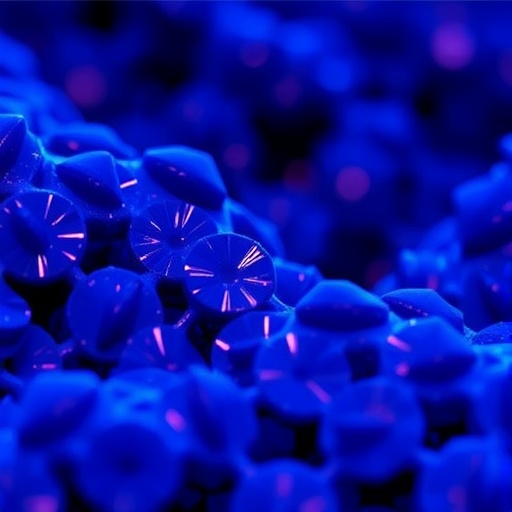The world of energy storage is undergoing a transformative journey, with lithium-ion (Li-ion) batteries leading the charge in making technology more efficient and portable. In recent research, scientists have explored the potential of nanoparticles to revolutionize Li-ion battery performance, especially in the anode material, where the choice of materials plays a crucial role in overall battery efficiency. A groundbreaking study by researchers Yakar, Sarf, and Bayırlı investigates the promising application of metal-doped Prussian blue nanoparticles, specifically those incorporating copper (Cu) and titanium (Ti), which are believed to enhance battery efficiency significantly.
Prussian blue has long been recognized for its unique structural and electrical characteristics, making it an intriguing candidate for energy storage applications, particularly as an anode material in Li-ion batteries. One of the key advantages of using Prussian blue is its ability to stabilize the structure during lithiation and delithiation processes. This stability translates to improved cycle life and efficiency, essential factors in the rapidly expanding market for rechargeable batteries used in consumer electronics, electric vehicles, and renewable energy systems.
The research conducted in this study not only delves into the structural properties of these nanoparticles but also emphasizes the importance of tuning their average particle and cluster sizes. By doped with metals like Cu and Ti, the structural integrity of Prussian blue can be enhanced, allowing for superior electronic conductivity and ion diffusion. This results in a more efficient charge and discharge cycle, subsequently leading to higher energy capacity in Li-ion batteries.
One of the critical findings of this study is the relationship between particle size and electrochemical performance. Smaller particle sizes in nanoparticles allow for a higher surface area-to-volume ratio, which is crucial in improving the kinetics of lithium-ion insertion and extraction. The researchers highlighted that the average particle sizes achieved through their novel synthesis process significantly impact the electrochemical behavior observed during battery performance tests.
Metal doping, particularly with Cu and Ti, has been noted to facilitate electronic and ionic transport within the Prussian blue lattice. This could potentially mitigate one of the long-standing challenges in battery technology: the slow rate of ion transport that often plagues larger particles. By enhancing the transport properties through careful doping, the researchers aim to create a new class of anode materials that can support faster charging times and improved energy density in Li-ion batteries.
In their experiments, the team utilized advanced characterization techniques such as scanning electron microscopy (SEM) and X-ray diffraction (XRD) to analyze the morphology and crystal structure of the synthesized nanoparticles. These tools provided valuable insights into how the dopants affected the arrangement and distribution of the Prussian blue structure, leading to better performance metrics during battery testing.
Another significant aspect of this research focused on the clustering of nanoparticles. By examining the cluster size, the researchers were able to identify how the aggregation of these nanoparticles could influence their electrochemical behavior. More uniform and smaller clusters were found to enhance the overall conductivity, making them better suited for use in Li-ion battery electrodes.
As ions move in and out of the anode material during charging and discharging, the design and architecture of the material become paramount. The incorporation of metal-doped Prussian blue nanoparticles promises not only to enhance traditional capacity limits but also to improve thermal stability and cycle life, further making them ideal candidates for next-generation batteries.
As sustainability becomes more integral to technology development, materials that are abundant, cost-effective, and less harmful to the environment will take precedence. The utilization of Prussian blue, which is derived from abundant materials, aligns with the growing demand for greener battery technologies. This positions metal-doped Prussian blue nanoparticles at the forefront of sustainable battery research.
Furthermore, the findings from this study have implications beyond just battery technology; they may also influence research in other fields, such as catalysis and sensors, where nanoparticle properties play a critical role. The distinct electrochemical qualities exhibited by these nanoparticles could pave the way for their use in a wide variety of applications if further optimizations and studies yield positive results.
The promising outcomes of this research point towards a future where enhanced energy storage solutions can seamlessly integrate with advancing technology. As ongoing demand for more efficient batteries fuels research and innovation, the application of metal-doped Prussian blue nanoparticles could represent a significant leap forward in developing batteries that meet the needs of consumers and industries alike.
Ultimately, the study led by Yakar, Sarf, and Bayırlı signifies a crucial step in battery research, making substantial contributions to our understanding of how material properties can be engineered for better performance. As the race towards efficient battery designs continues, it will be compelling to observe how these groundbreaking findings are synthesized into practical applications in the field of energy storage technology.
With advancements like these, the future of energy storage holds the promise of more efficient, sustainable, and capable batteries that could change the way we interact with technology in our daily lives. As researchers continue to explore the intersections of materials science and electrical engineering, we may be on the verge of witnessing a battery revolution that could reshape various sectors ranging from automotive to portable electronics.
As this field of study evolves, the incorporation of advanced materials like metal-doped Prussian blue nanoparticles will likely remain a focal point for future research, suggesting an exciting horizon for scientists and engineers working towards reliable and high-capacity energy storage solutions.
Subject of Research: Metal-doped Prussian blue nanoparticles for lithium-ion battery anode material.
Article Title: Average particle size and cluster size of metal (M: Cu, Ti)-doped Prussian blue nanoparticles for Li-ion battery anode material.
Article References:
Yakar, E., Sarf, F. & Bayırlı, M. Average particle size and cluster size of metal (M: Cu, Ti)-doped Prussian blue nanoparticles for Li-ion battery anode material.
Ionics (2025). https://doi.org/10.1007/s11581-025-06710-6
Image Credits: AI Generated
DOI: https://doi.org/10.1007/s11581-025-06710-6
Keywords: lithium-ion batteries, metal-doped nanoparticles, Prussian blue, energy storage, electrochemical performance, sustainable technology.




